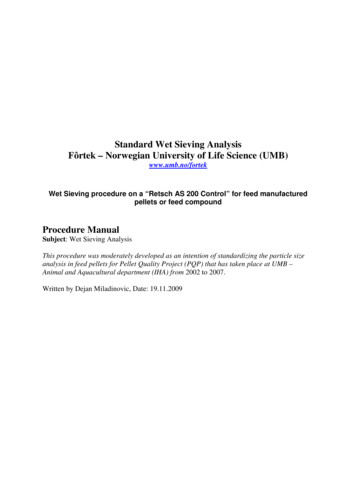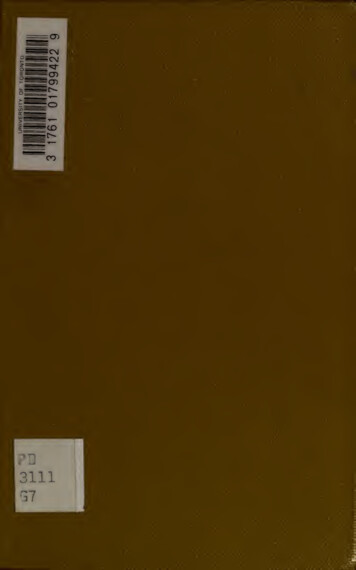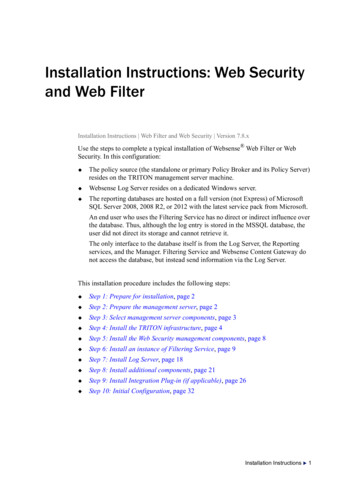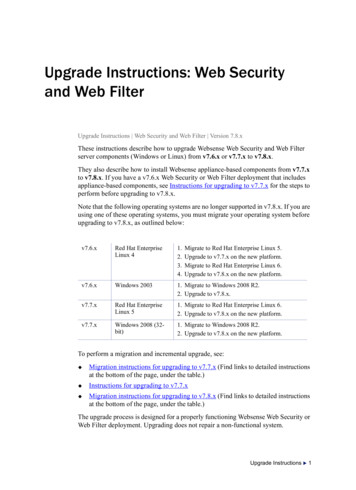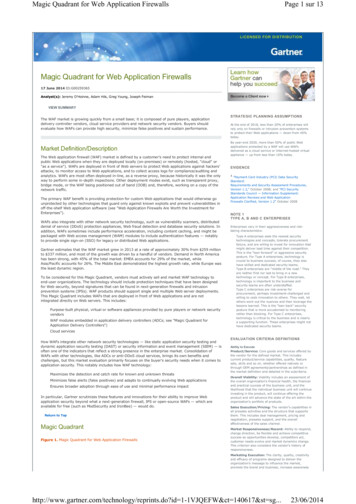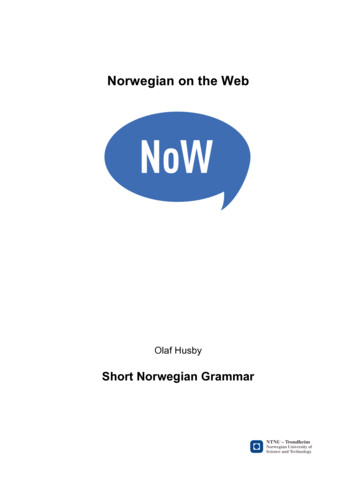
Transcription
Norwegian on the WebOlaf HusbyShort Norwegian Grammar
Norwegian on the Web, NTNUShort grammar 2ContentNouns . 4General . 4Common nouns . 4Proper nouns . 4Gender . 4Conjugation of nouns . 5The simple pattern . 5System used in this course . 5Verbs . 6Verbs - terminology . 6Regular verbs . 7Irregular verbs. 7Tenses and forms . 8Infinitive . 8Present . 8Preterite . 9Present perfect . 9Preterite perfect . 9Present future . 9Preterite future. 10Present future perfect . 10Preterite future perfect. 10Auxiliary verbs. 10Common auxiliary verbs . 10Modal auxiliary verbs. 11Adjectives . 12General . 12Agreement . 12Agreement: Attributive form . 12Agreement: Predicative form . 12Comparison . 13Comparison between two objects . 13Adverbs . 14General . 14Adverbs – adverbial . 14Modifying adjectives . 14Adverbs - form . 15Pronouns . 16General . 16Articles . 18Demonstratives. 19Determinatives. 21Possessives . 21
Norwegian on the Web, NTNUShort grammar 3Possessive expressions . 22Quantifiers. 22Cardinal Numbers . 22Ordinal Numbers . 23Old an new counting system . 23Countable/uncountable amounts. 23Countable amounts. 23Uncountable amounts . 23Quantifiers with grammatical agreement . 24Prepositions . 25Conjunctions . 26Subjunctions . 27General . 27Nominal function. 27Adverbial function . 27Adjectival function . 29Interjections . 30General . 30Interjections used for answers. 30Greetings . 30Sentences. 31Main clause . 31Subordinate clause . 32As the text book grammar is lacking descriptions of some word classes, we wouldlike to present a short review of all word classes in Norwegian.
Norwegian on the Web, NTNUShort grammar 4NounsGeneralNouns are words that name people, things, actions, places, states. Nouns aredivided in two subgroups, common and proper nouns.CommonnounsThese are nouns that name general items. In Norwegian common nouns are writtenwith lower-case letters (except when they occur after a full stop): “student” (student),“universitet” (university), “idé” (idea).PropernounsThese are nouns that name a specific item, often a “one-of-a-kind”. Proper nouns arewritten with upper-case letters: “Norge” (Norway), “Trondheim” (Trondheim), “Julie”(Julie).GenderIn Norwegian, nouns are grouped into three categories according to the noun'sgender (kjønn). This division is important as nouns are conjugated according to itsinherent gender.GendermasculinefeminineneuterNorwegian termhankjønnhunkjønnintetkjønnLiteral nder”In most cases the assignment of gender is arbitrary, and for learners of Norwegian itusually is difficult to guess the gender of a given noun.In general one may say that about 50 per cent of all nouns are of masculine genderabout 25 per cent of all nouns are of feminine genderabout 25 per cent of all nouns are of neuter genderHowever, as all feminine nouns may be conjugated as masculine nouns, 75 per centof all nouns may use articles for masculine nouns, and 25 per cent as articles forneuter nouns.
Norwegian on the Web, NTNUShort grammar 5ConjugationofnounsThe noun is an independent form in singular indefinite. Adding a suffix to the end ofthe noun makes definite form singular. Indefinite and definite form plural are madethe same way. The suffixes are listed below. The three dots are replacing anynoun.Two conjugation patterns are presented below. First you find the very basic rules.The simple patternmasculineSingularIndefiniteDefiniteen -enfeminineneuterei et -a -etPluralIndefiniteDefinite -er -ene -System used in this courseAs there are several exceptions, this extended version is presented. These patternswill cover most cases in this introductory course.masculineSingularIndefiniteDefiniteen -(e)nfeminineneuterei et -a -(e)tPluralIndefinite -(e)rDefinite -(e)ne -(e)r - -(e)ne -(e)ne -(e)r
Norwegian on the Web, NTNUShort grammar 6VerbsVerbs are words that name what is going on (actions, states of being, what exists).Norwegian verbs occur in several forms as a result of conjugation. The differentforms of a verb can be divided into-Finite forms, that is forms that express time (past, present) or modeInfinite forms, that is forms that do not express time or modeAs in English you will find both regular (“weak”) and irregular (“strong”) verbs.-Regular verbs form preterite (past tense) by adding a suffix to the stemIrregular verbs form preterite without adding a suffix to the stemNorwegian verbs are not conjugated in person and number.Verbs - terminologyIn this presentation the new standard terminology is used. The English translation ofthe new an old terminology (Strandskogen 1995) is shown below. Non-overlappingcategories are marked in grey.Strandskogen (1995)InfinitivePresentPast (Imperfect)PerfectPluperfectFutureFuture perfectConditionalConditional perfectGrammatical terminology applied in teaching esensPreteritePreteritumPresent perfectPresens perfektumPreterite perfectPreteritum perfektumPresent futurePresens futurumPreterite futurePreteritum futurumPresent future perfectPresens futurum perfektumPreterite future perfect Preteritum futurum perfektumNorwegian verbs occur in seven different forms. This is demonstrated below usingthe regular “øke” - “increase” and the irregular verb “skrive” - “write”.Verb formImperativeInfinitivePresentPreteritePerfect participlePresent participlePassive voiceStructurestemstem “-e”stem “-er”stem ending “-te”stem ending “-t”stem “-ende”stem sedincreasingis being increased
Norwegian on the Web, NTNUVerb formImperativeInfinitivePresentPreteritePerfect participlePresent participlePassive voiceShort grammar 7Structurestemstem “-e”stem “-er”internal changeinternal changestem “-ende”stem nwritingis being writtenThe verb forms above occur for both regular and irregular verbs. However, they areproduced in slightly different ways. Regular verbs produce preterite and presentperfect forms by adding a suffix to the verb. Irregular verbs produce preterite bychanging the stem vowel. The present perfect participle of irregular verbs in generalends in a “-t”.The present participle form is the adjectival form of the verb, and is used only asadjective or adverb, not as verb.et økende antallet gråtende barnan increasing numbera crying childRegular verbsThere are four classes of regular verbs. 1. class has two patterns. The “-et”-form isregarded as more formal than the “-a”-form.InfinitivePresent1. classå kaste-er2. class3. class4. classå lekeå leveå et-a-t-d-ddEnglishto throwto playto liveto reachIrregular verbsIrregular verbs produce preterite by changing the stem vowel. The present perfectparticiple in general ends in a “-t”. Irregular verbs are quite heterogeneous.Infinitiveå skriveå finneå antPresent perfecthar skrevethar funnethar vunnetEnglishto writeto findto win
Norwegian on the Web, NTNUShort grammar 8Tenses and formsBelow all forms and tenses of verbs are demonstrated using the regular verb “øke” “increase” (PP present participle, INF ePresent perfectPreterite perfectPresent futurePreterite futurePresent future perfectPreterite future perf
Norwegian on the Web, NTNU Short grammar 9 Preterite& In general one can say that this verb form is used to express actions that took part at a definite point of time in the past. The focus is on the action itself. Jeg spiste frokost klokka 10. I had breakfast at 10 o’clock. Present&perfect& In general one can say that this verb form is used to express actions that took part in the past, but .
